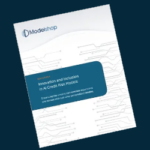Credit modeling is about to change as Millennials transform into your primary customer
As Millennials mature and take their place as the primary market segment for lenders, credit models will have to change in a significant way. As with most industry transformations, this change will be driven by competitive market dynamics but will be enabled by emerging technology that enables the market leaders to be more competitive.
For the last decade, most lenders haven’t focused their attention on Millennials (currently 20 – mid 30s). Millennials don’t buy cars; they live in cities and use Uber. Millennials don’t buy homes; they rent apartments. This is naturally starting to change. Thirty-year-old’s have a predilection for getting married and having kids. Inevitably, the ‘I’m never leaving the city’ evolves into ‘I need a yard and a SUV for our two kids’.
This generational shift is more important for lenders than prior generations because Millennials think about products differently than Generation X and Baby Boomers. They grew up with instant access to data, unlimited choices in entertainment and an expectation that the products they need are served up in an easy to consume way. The generation that never had to open a map is not prepared for a complicated or opaque loan application. They’re also not expecting to wait for an answer, and they’re certainly not used to being rejected.
Startups are reinventing the loan application, but they have yet to address the evolution of credit models
A ‘Millennials will change the game’ prediction isn’t new for many in the lending industry. It’s been over a decade since startups such as Lending Club and Prosper began working to address the looming need for a better application experience and flexible financing structures. Not surprisingly, a significant percentage of startups focus on student lending, arguably the first sector to be hit with the looming Millennial transformation. Startups do not have the same performance expectations as traditional lenders, however. They can leverage equity investments and fintech excitement to detract focus from portfolio profitability. Their vintages tend to be young, small and easily remarketed such that the importance of having high-performance risk and pricing models hasn’t been as high a priority as gaining market share. As a result, there hasn’t been substantial progress on how lending models need to shift to support the influx of Millennial borrowers. Time is running out as traditional Generation X borrowers move towards retirement and traditional lenders must make a move towards serving millennials as their primary customer base. A big part of that move will be changing how we build our credit risk and pricing models to better serve that generation’s needs.
Lending decisions need to be automatic, even in lower credit tiers, meaning models must be adaptive
Lending models that serve Millennials will need to be 100% automated if they expect to provide a real-time decision back to an applicant’s device. Anything less won’t be competitive, as Millennials will just move to the next option if they don’t get an instant answer. In the prime and super-prime spectrum, this isn’t much of a problem. These products have largely been automated for decades. Higher credit risk products, which are common for younger borrowers, will have more of a challenge moving to full automation because of the importance of the manual underwriting step in these spectrums today.
Full automation means our models have to be smarter and more adaptive, including the ability to prompt the applicant with additional questions based on information the model receives in real-time. When you think about ‘smarter models’, most people think just about analytics. Better math to give better answers. Certainly, leveraging predictive analytics is part of the solution, but automating the expertise of your underwriter is even more important. Intelligent automation going to be the more challenging requirement for the next generation of lending models.
As an example, if your risk model detects a lien on an applicant’s property, a typical underwriting process would be to ask the applicant to explain the lien, provide additional documentation and then make an expert decision whether the lien will adversely impact the borrower’s ability to repay the loan. This basic process will be the same in the fully automated world, it will just be instant. Predictive models will estimate the impact the lien will have on the probability of default, but the lending model also needs to be adaptive enough to ask for (or electronically retrieve) additional information and to run real-time projections to determine the lifetime impact on the profitability of the loan. This all has to happen in seconds before the borrower gets frustrated and moves to another lender.
Auto-structuring of loans to optimize for a borrower’s unique needs will become expected
A critical need to attract and convert Millennial applicants will be to make the optimal loan configuration the first or even the only option presented. The emerging generation of borrowers expect to be shown exactly what they are looking for by retailers and streaming services. They will expect the same from lenders. The era of sitting in the finance office at a car dealership while the finance officer picks through a list of potential programs based on the borrower’s (and her) financial needs is ending. Next generation lending models will be intelligent enough to predict the most likely loan structure (lowest payments vs. lowest lifetime cost vs. flexible payments) and will create a custom loan offer that maximizes the fit for the applicant, instantly. More educated borrowers will want to know their financing options before the walk into a dealership or put an offer on a home, and they’ll demand the ability to restructure the loan on the fly if their purchase decisions change.
This means two things from a technology perspective. First, predictive analytics, including market and conversion predictors, need to be built directly into decision and pricing models instead of being developed as static risk tables. Second, decision models will no longer be able to decision a single loan configuration. Instead, they will need to explore a spectrum of options, typically in multiple dimensions, to find the best ‘cost function’ value. For example, loan pricing may be determined by projected lifetime value of the loan to the lender weighted by conversion, default, and churn predictors. The loan structure that is the most likely to be accepted while maximizing the profit to the lender and creating a satisfied customer is what should be presented. To add to the complexity, that best solution may change on the fly as the borrower explores different purchase options.
This type of ‘non-linear solver’ technology is not new, it has been used extensively in operations research applications such as figuring out how to best pack your Amazon package in a UPS truck, but it is relatively new to the lending arena. More importantly, the entire lending technology stack will need to evolve to support optimized product configurations, decisions and pricing in real-time.
Increased use of AI will require additional data transparency and tools that statistically demonstrate lack of bias
One of the reasons credit modeling technology has been slow to evolve is the strict regulatory oversight of fair lending practices. ECOA Regulation B is fairly stringent on restrictions on use of protected classes of data that could impact decisions to grant credit. The problem with advanced predictive analytics is that some forms of models, such as neural networks or random forest decision trees, are not easily explained. Even if no data that could be construed as a protected class indicator is presented to the training algorithm (e.g. sex or national origin), there is a strong chance that highly fitted modeling technology can identify natural correlations with these attributes and as a result inadvertently violate the regulation. This is the reason the FICO score is still fundamentally a scorecard; it is explainable. On the other hand, if lenders can’t leverage advanced predictive technologies, there is no way to deliver the seamless and personalized lending experience Millennials have come to expect and demand. The future of lending models will need to solve this issue. Modeling tools will need to become incredibly transparent, allowing users to not only trace back to the source of each data point that impacts a decision, but to also include integrated back-testing and simulations that can prove statistically that correlation bias is not impacting credit policy.
The next generation of modeling tools are beginning to address this. The same ontology-based logic modeling that is used in technologies that track fraud or optimize airline schedules is starting to be applied to credit models. Ontologies are data structures that model domains of knowledge as graph-based information. By building credit models based on ontologies, lenders will be able to more flexibly leverage creative predictive analytics while ensuring that their models are explainable and do not expose the lender to unexpected regulatory risk.
The ability to rapidly test, learn and iterate will become more critical for handling increased applicant diversity
The emerging generation of borrowers will not look like the last generation. Traditional employment, living arrangements and social structures are changing and our classic way of looking at risk will have to change as well. How long someone has been with their employer or the fact that an applicant didn’t work for a year while traveling are no longer clear indicators of earning potential. Emerging credit decision models will have to be highly adaptive and be able to adjust rapidly with new data and performance insights. This is not easy for most traditional lenders using traditional modeling tools.
The problem that many lenders face is the lack of agility in rapidly deploying new credit models. It’s fine to work with historic data in Python or SAS (or even Excel) and to come up with creative ideas on how to increase conversion rates and book better loans, but if your new idea takes four months for your IT team to code it into your origination tool you’ve missed the opportunity. More importantly, once a new model is deployed, it needs to be monitored and adjusted in real-time based on what you learn from production performance metrics. Top analytic companies like Amazon and Google iterate these learnings and produce new models in days, or even hours. Lenders typically can’t approach this level of agility and the current multi-month cycle for updating models will no longer be competitive as some lenders evolve. New technology and more agile competitors are beginning to enter the lending market. It will be hard for traditional lenders to compete, unless they fundamentally change the way they build, test and deploy their credit models.
Getting a loan is a more personal experience than most other transactions
This is an exciting time in the Lending industry. There have been many starts and stops around the evolution of credit modeling in the last decade, but the threat of FAANG (Facebook, Amazon…) and similar players entering the lending/credit market is finally going to require us to accelerate our innovation in credit modeling. Emerging technologies like Modelshop have the ability to help traditional lenders level the playing field and there is still hope that this industry can avoid the massive tech giant rollup experienced in the marketing and retail space. Ironically, getting a loan is a more personal experience for many people than most other transactions they experience. I believe there is more nuance in the relationship and service that a more specialized lender can provide. Our company vision is to help companies across multiple industries upgrade their modeling technology platforms to be more agile and to help automate their model delivery tools to drive more competitive business performance.
Tom Tobin is Modelshop’s CEO and Founder. He has been building automated modeling solutions in the credit and fraud space for over 25 years as a technology leader at FICO, Fiserv, Oracle and HP.






